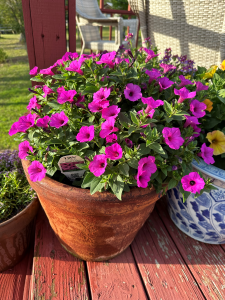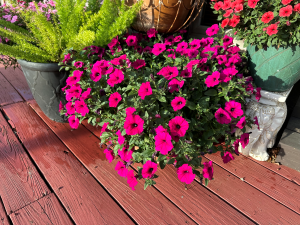Florida is a fun state to live in for many reasons. You are never more than an hour or two away from a great beach, it never gets bitterly cold, and the fishing is phenomenal. I could go on. More than all that though, my favorite thing about living in Florida is the ability to have something blooming year-round, even in the cool months. This year, the stars of the spring show in my backyard container garden have been new selections of an old favorite, the Petunia.
Petunias, a close relative of Tobacco, originally hail from South America. And while the original petunia species were not a valuable crop like Tobacco, enterprising European explorers realized the group had horticultural potential. By the late 1800s, plant breeders had begun hybridizing wild petunia and the petunias gardeners now recognize took shape! Fast forward to today and petunias are the most popular bedding plants in the US, with annual petunia sales topping $260 million (USDA’s Census of Horticultural Specialties). More than 700 petunia cultivars have received plant patents, comprising all manners of sizes and flower colors. This year, there is even a controversial genetically modified petunia called ‘Firefly’ hitting the market that displays bioluminescence – it literally glows in the dark!

Petunia ‘Jazzberry’ growing in a container. Photo Credit: Daniel Leonard, University of Florida/IFAS Extension – Calhoun County
In the past, petunias struggled in the Deep South, as they were often ravaged by various fungal pathogens induced by our too-warm weather. These old-fashioned petunia cultivars, while pretty on store shelves, don’t perform as well in the heat as newer varieties bred for warmer, wetter conditions and that possess enhanced vigor and disease resistance. When shopping for petunias in the Panhandle, avoid anonymous petunia varieties of questionable quality and look for modern named hybrids, for example the Supertunia Series, the SuperCal series, and the Wave series. These improved hybrid petunias are resilient to pesky diseases like Botrytis Rot, flower heavily over a longer period, and tolerate temperature extremes better. Within these series, individual cultivars vary in flower color, flower size, and overall plant size (ranging from mounding monsters growing 4’ in diameter to tiny dwarfs that barely span 18”). I grew several varieties from each of these series this year and all performed wonderfully. There’s a petunia variety for every garden!

Petunia ‘Supertunia Royal Magenta’. Photo Credit: Daniel Leonard, University of Florida/IFAS Extension – Calhoun County
Once you’ve picked a quality cultivar, petunias are relatively easy to grow! In the Panhandle, petunias are grown as cool season annuals – planted in the fall (October-November) and grown through about May, finally playing out once the summer heat arrives. Petunias prefer full sun and are at home in containers filled with a quality potting mix (container size will vary from medium to large depending on the growth habit and mature size of the petunia). Petunias are not particularly drought tolerant and prefer regular water and fertilizer to look their best. I water my containers each day during sunny and warm conditions, backing off to every other day or less during cooler, cloudy weather. Because of their floriferous nature, petunias are also relatively heavy feeders and appreciate supplemental fertilizer. I top dress petunia containers with Osmocote or similar slow-release fertilizer at planting and supplement with liquid fertilizer every week to ten days during the peak of the flowering season.

Petunia ‘Supertunia Mini Vista Scarlet’. Photo Credit: Danial Leonard, University of Florida/IFAS Extension – Calhoun County
Though it’s past petunia planting time this season, be on the lookout for petunias to hit nursery shelves next fall. Simply pick a good hybrid cultivar, plant in a container in full sun, water and fertilize regularly, and you’ll be rewarded with no-fuss, months-long color until the summer heat finally draws the curtain on the show! For more information about petunias or any other horticultural topic, feel free to contact us at the UF/IFAS Calhoun County Extension office. Happy gardening!
- Mulch is a Must in Your Landscape - December 4, 2025
- Tis the Season – Why Winter is the Best Time to Plant Trees and Shrubs - November 26, 2025
- Feeling Blue (Ginger) This Fall - November 13, 2025
